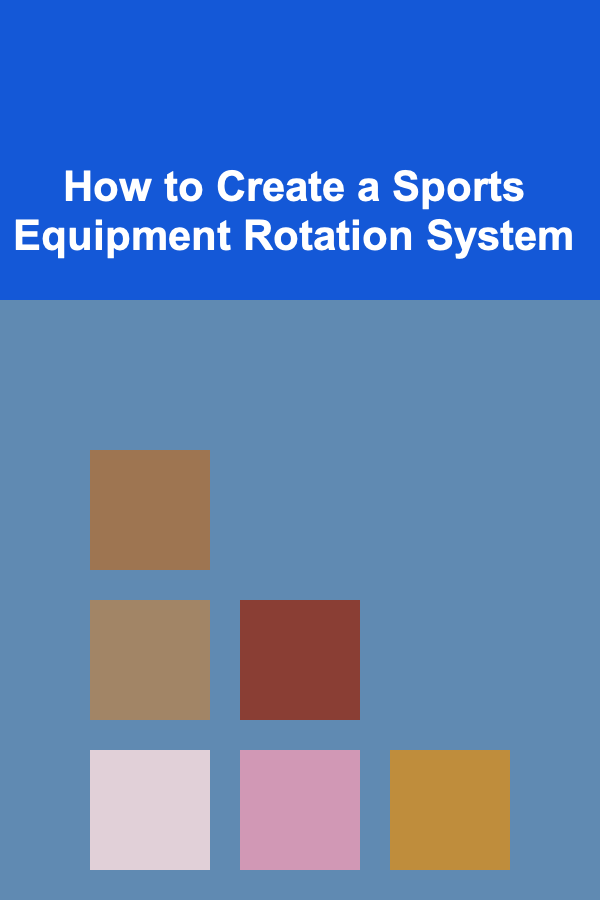
How to Create a Sports Equipment Rotation System
ebook include PDF & Audio bundle (Micro Guide)
$12.99$9.99
Limited Time Offer! Order within the next:

Managing sports equipment can become a daunting task, especially for athletes, coaches, and fitness enthusiasts who own multiple items for various activities. A sports equipment rotation system not only helps in maintaining the longevity of gear but also enhances efficiency, organization, and usability. This comprehensive guide will take you through the steps necessary to create a successful sports equipment rotation system tailored to your needs.
Understanding the Importance of a Rotation System
A rotation system for sports equipment involves systematically using different items over specified periods. This approach offers several benefits:
1. Longevity of Equipment
Regularly rotating your gear prevents excessive wear on any single item, extending its lifespan.
2. Improved Performance
Using a variety of equipment allows you to adapt to different conditions and enhance your performance across various contexts.
3. Enhanced Organization
A well-defined rotation system creates an organized environment, ensuring everything is easy to find and ready for use.
4. Cost Efficiency
Investing in various equipment becomes more worthwhile when you maximize usage and minimize replacements due to damage or neglect.
5. Encouragement of Versatility
By rotating equipment, you may discover new interests or skills, encouraging a diverse range of activities.
Understanding these advantages lays the groundwork for developing a structured sports equipment rotation system.
Assessing Your Equipment
Before creating your rotation system, it's essential to assess your current sports equipment inventory. Here's how to do it effectively:
1. Inventory Audit
Conduct a thorough inventory of all your sports gear. List each item, including:
- Type of equipment (e.g., balls, weights, bikes)
- Condition
- Frequency of use
- Any specific features or limitations
2. Evaluate Usage Patterns
Consider how often you use each piece of equipment and for what purpose. This evaluation assists in identifying which items should be included in your rotation.
3. Identify Redundancies
Examine if you have duplicate items that serve similar purposes. Decide whether to keep them for emergency purposes or let go of less used ones.
This assessment phase is crucial for understanding the scope of your rotation system and determining what gear is needed.
Establishing Goals for Your Rotation System
After assessing your equipment, establish clear goals for your rotation system. Goals help provide direction and focus:
1. Set Specific Objectives
Identify what you want to achieve with the rotation system. Possible objectives might include:
- Increasing the lifespan of equipment
- Ensuring all gear gets regular use
- Enhancing your physical training by diversifying workouts
2. Define Metrics for Success
Decide how you will measure the success of your rotation system. Consider metrics such as:
- Frequency of use for each item
- Condition reports after scheduled rotations
- User satisfaction and comfort level with each piece of gear
Establishing clear goals will guide your decisions throughout the process of creating your rotation system.
Categorizing Your Equipment
Organizing your equipment into categories simplifies the rotation process. Consider these common methods for categorization:
1. By Sport or Activity
Group items based on the sport or activity they are intended for. For example:
- Team Sports: Soccer balls, basketballs, helmets
- Individual Sports: Tennis rackets, golf clubs, running shoes
- Fitness Equipment: Weights, resistance bands, mats
2. By Frequency of Use
Classify equipment into categories based on how frequently you need them. This could include:
- Daily Use: Items used for regular workouts (e.g., gym shoes)
- Weekly Use: Gear required for weekly games or classes (e.g., team uniforms)
- Seasonal Use: Equipment utilized for specific seasons (e.g., skis, surfboards)
3. By Size and Weight
Organizing equipment by size and weight can also be beneficial, particularly for storage and transportation. Group smaller, lightweight items separately from bulkier or heavier gear.
Categorizing your equipment aids in establishing a clear framework for your rotation system.
Developing a Rotation Schedule
Creating a rotation schedule is one of the most critical components of your system. Here's how to develop an effective plan:
1. Determine Rotation Frequency
Decide how often you want to rotate your equipment. Options include:
- Weekly: Rotate items out every week.
- Monthly: Change up gear once a month.
- Seasonally: Adapt the rotation based on seasonal changes in sports or climate.
2. Plan Rotation Sequence
Establish a sequence for rotating each category of equipment. For instance:
- Week 1: Team sports gear
- Week 2: Individual sports equipment
- Week 3: Fitness gear
3. Create a Calendar
Utilize a calendar, planner, or digital tool to track your rotation schedule. Document when you'll switch items and any maintenance needs associated with them.
4. Allow Flexibility
Be prepared to adjust your schedule as needed based on availability or personal circumstances. Life can be unpredictable, so adaptability is key.
A well-structured rotation schedule ensures that all equipment receives adequate use while adhering to your goals.
Implementing Your Rotation System
With a clear plan in place, it's time to implement your rotation system. Follow these steps for effective execution:
1. Organize Storage Space
Designate a specific area for your sports equipment. Ensure this space is organized by categories established earlier, making access straightforward.
Tips for Effective Storage:
- Use shelving units, bins, or hanging organizers to keep things tidy.
- Label each section clearly for quick identification.
2. Communicate the System
If multiple people are involved---such as family members or teammates---ensure everyone understands the rotation system. Clear communication prevents confusion and ensures adherence to the schedule.
3. Track Usage
Monitor equipment usage, marking off items on your calendar when they've been used. This record helps identify trends and informs any future adjustments to your rotation.
4. Regular Maintenance Checks
Schedule periodic inspections of your equipment to assess its condition. Is it wearing down? Does anything need repairs? Integrate maintenance into your rotation system.
Implementing your rotation system effectively sets the stage for long-term success.
Maintenance and Care
Caring for your sports equipment is paramount to prolonging its life, and integrating maintenance into your rotation system is essential.
1. Cleaning Procedures
Establish cleaning routines for each type of equipment. Different items will require varying levels of care:
- Bikes: Clean chains, check tires, inspect gears regularly.
- Weights: Wipe down with disinfectant wipes post-use.
- Clothing: Wash gym wear according to care instructions after each use.
2. Inspection Checklists
Create inspection checklists tailored to each equipment category. Include items like:
- Physical condition (cracks, tears)
- Functionality (moving parts, tension)
- Cleanliness
3. Repair Protocols
Have a clear process for addressing repairs:
- Designate a specific area for items needing repair.
- Keep a toolkit handy for minor fixes.
- Schedule professional servicing for complex equipment.
4. Documentation
Maintain records of when equipment was last cleaned, inspected, or repaired. This documentation will assist in maintaining accountability.
Following proper maintenance procedures keeps your gear functional and safe while promoting a longer lifespan.
Evaluating and Adjusting Your System
As with any system, regular evaluation is key to sustaining effectiveness. Here's how to review and optimize your sports equipment rotation system:
1. Collect Feedback
Gather input from users regarding their experiences with the rotation system. Questions to ask include:
- Are there issues accessing certain equipment?
- Is the rotation frequency effective?
- Do users feel prepared and equipped for activities?
2. Analyze Usage Data
Review data concerning equipment usage patterns. Are certain items underused? Adjust the rotation schedule accordingly.
3. Revisit Goals
Periodically revisit the initial goals set for the rotation system. Are they still relevant? Do they need adjustments based on changing priorities or circumstances?
4. Make Necessary Adjustments
Based on feedback and data analysis, adapt the rotation system to address any shortcomings and improve overall functionality.
Regular evaluations and adjustments ensure your sports equipment rotation system remains relevant and efficient.
Common Challenges and Solutions
Implementing a sports equipment rotation system may come with challenges. Here are some common obstacles and potential solutions:
1. Inconsistent Usage
Challenges: Some equipment may be neglected, leading to uneven wear.
Solutions:
- Reassess your rotation schedule to encourage greater use of underutilized items.
- Introduce incentives for trying out less popular gear.
2. Cluttered Storage Space
Challenges: Overcrowded storage areas can lead to disorganization.
Solutions:
- Periodically declutter and remove items no longer needed.
- Utilize vertical storage solutions to maximize space.
3. Forgetting the Rotation Schedule
Challenges: Users may forget when to switch equipment.
Solutions:
- Use digital reminders, alarms, or shared calendars to stay on track.
- Regular check-ins with all users to reinforce commitment.
4. Damage During Rotation
Challenges: Moving equipment can sometimes lead to accidental damage.
Solutions:
- Implement careful handling protocols during transitions.
- Train all users on proper storage and movement techniques.
Being aware of these challenges and preparing proactive solutions contributes to maintaining a smooth operation.
Conclusion
Creating a sports equipment rotation system is a strategic way to enhance organization, improve equipment lifespan, and promote versatility in sports activities. Through careful assessment, goal setting, categorization, and implementation, you can establish a dynamic system that adapts to your needs.
Regular maintenance, evaluation, and readiness to adjust further strengthen your system, ensuring it remains effective over time. By embracing a thoughtful approach to managing your sports gear, you can enjoy greater efficiency, improved performance, and a more satisfying sporting experience. Embrace the power of rotation and reap the rewards of a well-organized athletic life!

Essential Money-Saving Tips for College Students on a Tight Budget
Read More
How to Provide Mental Stimulation for Your Pet at Home
Read More
How to Store and Organize Your Hose and Watering Equipment
Read More
How to Utilize Dollar-Cost Averaging in Volatile Markets
Read More
How to Understand Bird Breeding Habits
Read More
How to Navigate Picky Eating with a Toddler Behavior Planner
Read MoreOther Products

Essential Money-Saving Tips for College Students on a Tight Budget
Read More
How to Provide Mental Stimulation for Your Pet at Home
Read More
How to Store and Organize Your Hose and Watering Equipment
Read More
How to Utilize Dollar-Cost Averaging in Volatile Markets
Read More
How to Understand Bird Breeding Habits
Read More